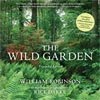
One does not lightly pass up a book with a note on the cover that says “Gardeners owe all to William Robinson” – Henry Mitchell.
Nor should one take lightly a book that uses the word “copse” in it, as in,
“My object in The Wild Garden is now to show how we may have more of the varied beauty of hardy flowers than the most ardent admirer of the old style of garden ever dreams of, by naturalizing many beautiful plants of many regions of the earth in our fields, woods, and copses, outer parts of pleasure grounds, and in neglected places in almost every kind of garden.”
One should read that book, which in this case is The Wild Garden: Expanded Edition By William Robinson and Rick Darke, with new chapters and photography by Rick Darke (Timber Press, $29.95).
The “old style of garden” that Robinson writes of is a garden laid out, Victorian style, with tender annuals and “exotic plants” that produce that lush summer display, but are gone with the first frost and must be replanted the next spring
This is a fascinating book. Darke has taken the 5th edition of The Wild Garden by William Robinson, published in 1895, and wrapped it carefully in a 21st century introduction and guide for how one might apply the concepts of Robinson’s 19th century “wild garden” to today’s garden.
I’ve found it very useful in helping me visualize how I would like to plant part of my backyard garden, the part where there will be a copse. Do you know what a copse is? When I wrote an email to introduce myself to the garden designer I’m now working with, I noted that I wanted a copse in my garden, a thicket of small trees and shrubs, planted in an informal style. And yes, she has included a copse, admittedly a small one, in the plan for my back yard gardens.
Robinson advocates in The Wild Garden, which he originally wrote in 1870, for moving away from stiff, formal gardens toward those gardens that allow plants to grow, flower, and fade without having to constantly maintain or re-plant them. He provides several reasons “for thinking wild gardening worth practicing by all who wish our gardens to be more artistic and delightful”. He contends the hardy plants will thrive in the “rough places” in the garden, and they will look “infinitely better than they ever did in formal beds”.
I wonder if my garden designer has read this book? I think Robinson, over 140 years ago, beautifully describes what I hope to have in at least part of my garden, starting with a copse, and expanding out from there, a place where plants can grow and colonize themselves, where they can sprout, flower, and gracefully die back without requiring extraordinary measures to hide fading foliage or provide awkward support, a place where I can just go and enjoy being in a garden.
Yes, I believe Henry Mitchell may have been right. “Gardeners owe all to William Robinson” for moving gardeners long ago away from the formally planted summer garden to a natural, sustainable garden that can be enjoyed in all seasons. And we owe thanks to Rick Darke for bringing this book back to us, some 140 years after it was first written, to show us how to achieve our own “wild gardens”, in several styles, ranging from my dreamed of copse to prairie gardens and meadows.
(I received a review copy of this book from Timber Press, at my request.)


This sounds like my kind of garden. How large is your garden? I always think of a copse as being a large area.
Copse is a word I usually associate with the English countryside and poets…your garden is going to be quite a sanctuary, Carol. Perhaps you should add another bench there for the days you feel like writing poetry:)
Funny, but just yesterday I was thinking about turning the former pasture on the other side of the drive into one big meadow. I should check out this book.
It's always nice to pop onto your site and learn something new…I have a copse, and never knew it!
Goodness, I thought you had mistyped "corpse", and I was wondering what exactly you plant back there! I've learned something new.
Funny, I was actually bidding on an earlier edition a few weeks back on an auction site. I didn't win, unfortunately. I'll give the new version a look.
It will be interesting to see your designer's take on a coppice. Do you already have small trees, or will you be planting those?
We had machinery out yesterday pruning and trimming what might be called a copse here, of various natural and planted trees and bushes.
It sounds very good. William Robinson and Gertrude Jekyll are the two people who have most influenced gardening in my opinion. Thanks.~~Dee
Sounds like a great read, I'll have to check it out.
Thanks for posting the info.
This post brought to mind a small, locally (MN) published book that explored the author's own desire and creation of a natural, sustainable garden. It is by Evelyn Hadden, titled 'Apprentice to a Garden' , by LessLawn Press. I think you would find it echoes your dreams also.